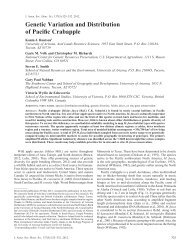CONSERVATION
Conservation You Can Taste - The Southwest Center - University of ...
Conservation You Can Taste - The Southwest Center - University of ...
- No tags were found...
You also want an ePaper? Increase the reach of your titles
YUMPU automatically turns print PDFs into web optimized ePapers that Google loves.
VEGETABLES, LEGUMES,<br />
GRAINS & ROOT CROPS<br />
As of 2005, when Monsanto took control of Seminis, its new subsidiary had<br />
already cornered an estimated 40% percent of the U.S. vegetable seed market and<br />
20% of the world market. In other words, one company (Seminis) alone provided<br />
the patented or PVPA-certified seedstocks for 85% of the chile and bell peppers,<br />
75% of the tomatoes, and 55% of the lettuce on U.S. supermarket shelves, in<br />
addition to having a prominent position in the seed production for beans, broccoli,<br />
cabbage, cucumbers, melons, peas, spinach and squash. At both the national and<br />
international levels, large U.S.-based seed companies have consolidated power over<br />
much of the genetic materials upon which our fresh vegetable supplies and our food<br />
security depend.<br />
Nevertheless, there are at least 275 other vegetable seed companies in the U.S.<br />
and Canada, up from an all-time low of just 215 companies in 1987. From 1984, when<br />
99 vegetable, grain, legume, tuber and herb varieties were listed in North American<br />
seed catalogs, the diversity rose 31% to 6483 varieties in 1994, and increased another<br />
31% to 8494 in 2004. Many on-line, niche market seed listings have cropped up since<br />
2004, making it almost too difficult to track the growth of the seed outlets which are<br />
dramatically diversifying the alternative food networks of North America.<br />
But just how are the food networks from farm to restaurant or home kitchen actually<br />
diversifying? With data made available from the last twenty-two years from Seed Savers<br />
Exchange archives, we tracked fifteen of what were once the rarest annual heirloom<br />
crop varieties that have boarded onto the Ark of Taste, from Amish Deer Tongue lettuce<br />
to White Sonora wheat. In 1981, most of them were available from only one or two<br />
seed catalogs, and only a handful of backyard seed savers grew them, let alone many<br />
commercial farmers. Today, these fifteen heirloom varieties are offered by an average of<br />
113 commercial growers who post their produce inventory on localharvest.org, and an<br />
average of six catalogs and on-line “mail order” inventories offer their seeds today.<br />
Some of the recoveries—as you can read in the sidebars—are nothing short of<br />
16



